Konami’s Arcade Classics Anniversary Collection (Nintendo Switch) Review
By Gabriel Jones  04.06.2019
04.06.2019
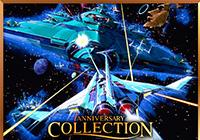
When it comes to arcade games, there are few developers with a library as strong and diverse as Konami's. Where else could players tackle the dangers of an alien body in Life Force, whip their way through a vampire's castle in Castlev…uhh…Haunted Castle, or engage in Twinbee, the world's first "cute em' up"? Welcome to the Arcade Classics Anniversary Collection, courtesy of Konami. Seven classic shmups and one not-so-classic sidescroller are included in this set.
For decades, Konami was one of the best videogame developers out there. It's only natural to expect that they'd eventually dip into their rich history for re-release material. Indeed, both their Dracula-whipping and alien-shooting flagship franchises will see compilations on every major platform. For now, however, let's focus our attention on the Arcade Classics Anniversary Collection. This critic is a huge fan of arcade games, and Konami's are some of the best around. This is as perfect an opportunity as ever to take a nice long look at the eight titles included in this set. Fair warning: there's a lot of ground to cover, so feel free to grab a comfortable seat.
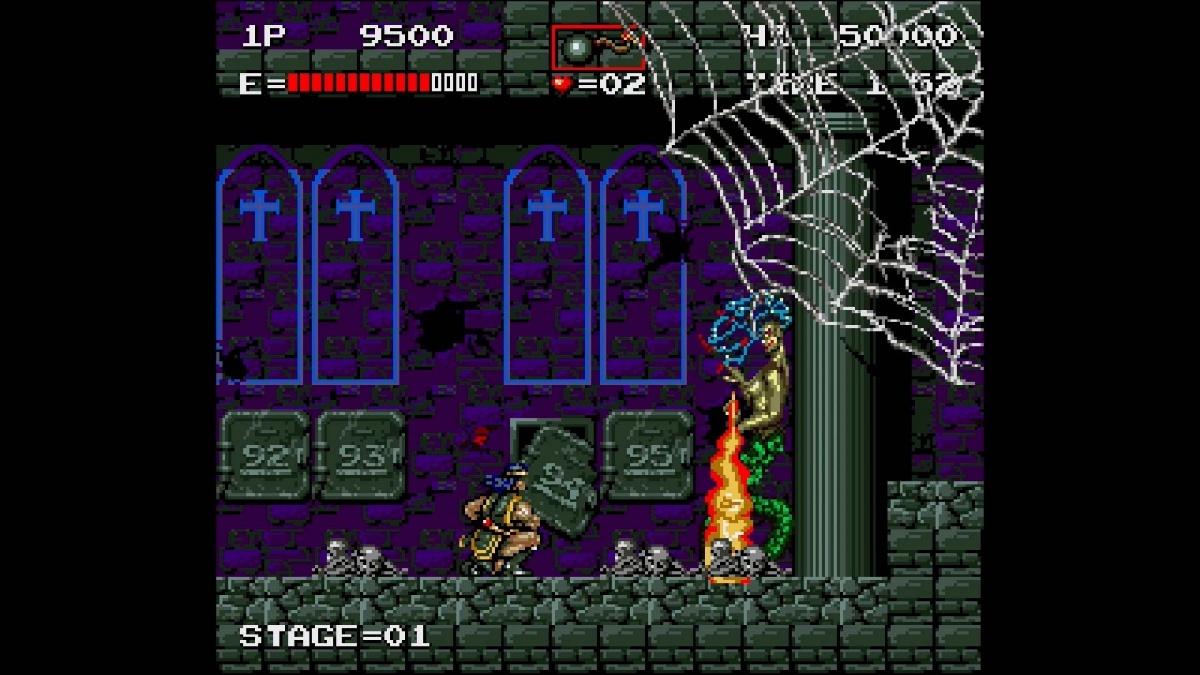
Haunted Castle
In order to rescue his beloved, Simon Belmont must destroy the dark lord Dracula. Much like the Castlevania games, the vampire hunter uses a variety of sub-weapons to rid the world of evil. Oddly enough, that's the extent of the similarities. Haunted Castle takes a different approach. It's still methodical, but puts less of an emphasis on precise platforming and diabolical enemy placement. Think of it as more of a typical hack & slash, but with the occasional gimmick. Simon slowly moves from left to right (and sometimes to right to left), while being hounded by a slew of adversaries. Other obstacles, such as collapsing graves and possessed flying bricks, are commonplace.
The level of difficulty is almost notoriously high, even for a "Castlevania" game. Simon is an absurdly large target. Whether it's a bat that nips the heel of his boot, or a speck of fire that singes the hairs on his head, everything that makes the slightest contact does damage. Pools of water and bottomless pits are as common (and fatal) as ever. Survival is dependent on the player having intimate knowledge of every situation, and being able to react accordingly. Its trial and error gameplay, but every error is severely punished.
Where it gets to be outright brutal is that Simon doesn't have any spare lives to work with. He has a health meter, but enemies can easily take a quarter of it in a single hit. Don't bother checking the walls for secret pork roasts either, because healing opportunities are incredibly hard to come by. Worst of all, even though there are continues, they tend to force the player into extremely difficult checkpoints. They're also far away from where Simon died, adding further insult to injury.
All told, this game doesn't understand its audience. Every stage is a series of aggravations, but with none of the satisfaction that Konami titles are typically known for. It feels more like being treated to a series of middle fingers, rather than anything resembling fun. Even seemingly minor issues like fleamen taking more than one hit to kill don't serve any purpose. Was it the developer's intention to make Haunted Castle the biggest pain in the arse imaginable? In this critic's eyes, they definitely succeeded.
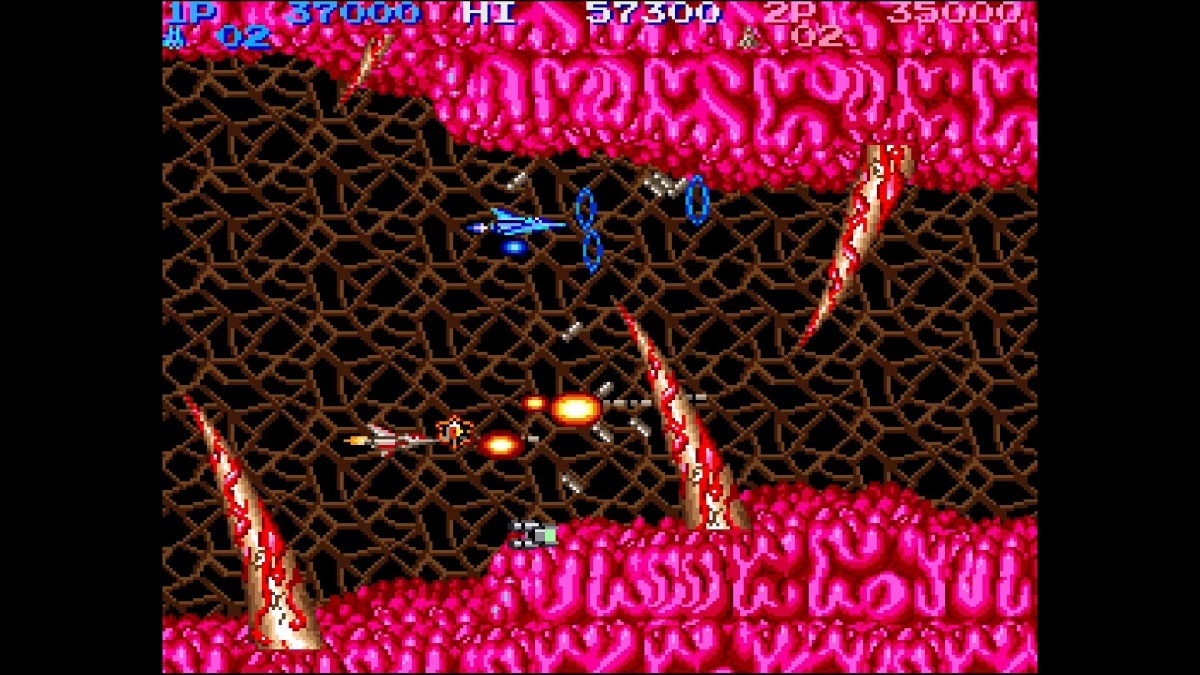
Life Force
In this STG, players must pilot a ship deep into the literal heart of a hostile alien lifeform. Honestly, flying inside of a body just might be one of the weirdest premises for a shmup. The second stage, for example, takes place in what can only be considered the Ureter. Among the various enemy ships that must be shot down, there are hundreds of indestructible kidney stones. I had a kidney stone once; it was the most pain I've ever experienced. Hundreds of them, impervious to the latest in space-age technology, why that's just flat-out insane. Forget ghosts, monsters, and Cthulhu, because this is real horror. The third stage takes place in the stomach, which is filled to the brim with swirling streams of fire. Somebody at Konami had way too many nachos when they came up with this silliness.
Anyway, Life Force starts off solid enough, kind of like a more accessible rendition of their Gradius instalments. There aren't any checkpoints, and options can be recovered upon death. The game itself consisting of three horizontal and three vertical stages is also a pretty unique approach. The standard moment-to-moment gameplay, which consists entirely of shooting down enemies whilst dodging their bullets, isn't bad either. It's not an especially deep shooter, and that's fine. Anyone with an appreciation for the genre should be able to jump into this quite easily.
Unfortunately, things fall apart by the end of stage 4. On its own, the boss isn't anything special. There are three cores that spit bounding balls everywhere. It's just a matter of dodging the blue death orbs and shooting the core. Seems easy enough… right? Wrong! The constant barrage of invincible orbs guarantees that only the best of the best have a chance of surviving. The pattern is somewhat predictable, as the spheres home in on the ship's general position. However, it only takes seconds for them to fill the screen, flying in every direction possible, all at the same time.
Thanks to the convenient save-state function provided by this compilation, I was able to spend well over 30 minutes trying to figure out a method to this madness. Unfortunately, every attempt resulted in failure. Keep in mind that normally there aren't any continues, so players would have to start over from the very beginning, just to get another shot at the fourth boss. The rest of the game is an extremely easy ride, but the boss is an absolute brick wall, and that doesn't make any sense. Difficulty is supposed to be a sensible upward climb, not a sheer cliff covered in grease.
Anyone interested in Life Force is better off hunting down a copy for the NES, or playing the Japanese version Salamander. There's also a revised version of the arcade game. Just like the console release, it features the Gradius power-up system. In any case, yes, the fourth boss makes an appearance, but it throws one orb at a time instead of two, so the screen doesn't get nearly as cluttered.
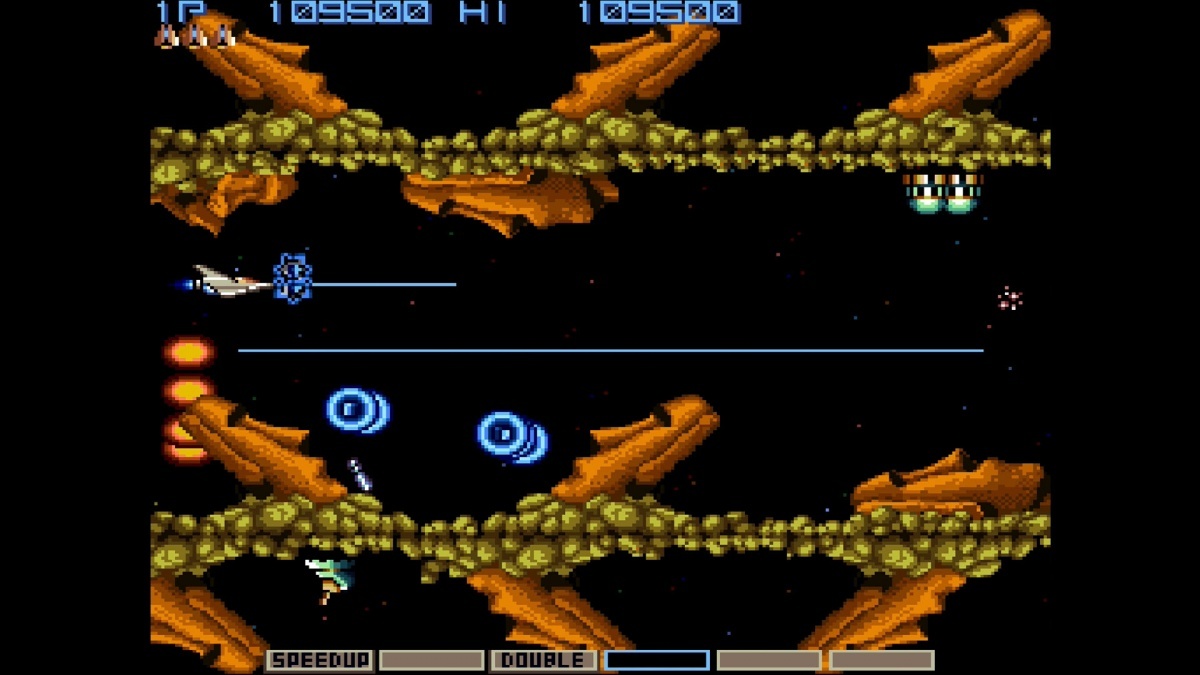
Nemesis
Back in 1985, Konami released Gradius, one of the most influential shmups of all time. Since then, there have been countless sequels, tributes, and even clones. Considering just how many games there are these days, it's pretty easy to forget about the one that started them all. Does the original still hold up? For the most part, yes it does. While it lacks the more creative level-design and complex scenarios of its successors, it still delivers on the fundamentals.
Nemesis, for all intents and purposes, is the same game. Players take control of the awesomely-named Vic Viper and attempt to stop the Bacterian Empire. Building up an arsenal capable of destroying this menace requires an understanding of the "power meter". Whenever power-ups are obtained, various armaments & upgrades are highlighted. When the player sees something they want, they just have to press the respective button to equip it. However, if they collide with a bullet or wall and lose a life, then all of their power-ups are lost. Also, since this is a checkpoint shooter, the chances of getting kicked back to nasty section with little chance of recovery are pretty high.
In order to counter this possibility, Konami created a "rank" system. Whenever power-ups are collected, the enemies become more aggressive. Not only do they move faster, but they also have a greater propensity towards firing loads of bullets. Whenever the Vic Viper is destroyed, the rank is reset. Unfortunately, this system isn't quite as balanced as it could be. Starting over from scratch is extremely difficult. Nemesis attempts to address this issue by including more power-up dropping foes. However, this results in the rank rising much more quickly.
Given the choice, it's probably best for new players to try their hand at Gradius first. In Nemesis, the rank spirals out of control as early as stage 2. What would normally be a fairly simple stage suddenly becomes a maze filled with death-traps. If the player doesn't take the right path or quickly eliminate the opposition, they'll find themselves facing a nearly impassable hail of bullets. Stage 3 is also an endless fountain of aggravation, because the famed Moai Heads can and will flood the screen with death.
It's really strange how it works out. Two of the earliest stages in the game can potentially become two of the hardest. Of course, that's not to say the rest of the Vic Viper's trek will be a cakewalk, but the truly dastardly scenarios are few and far between. Anyone with patience and dedication will have fun with this title, but others might want something a little more accessible and forgiving.
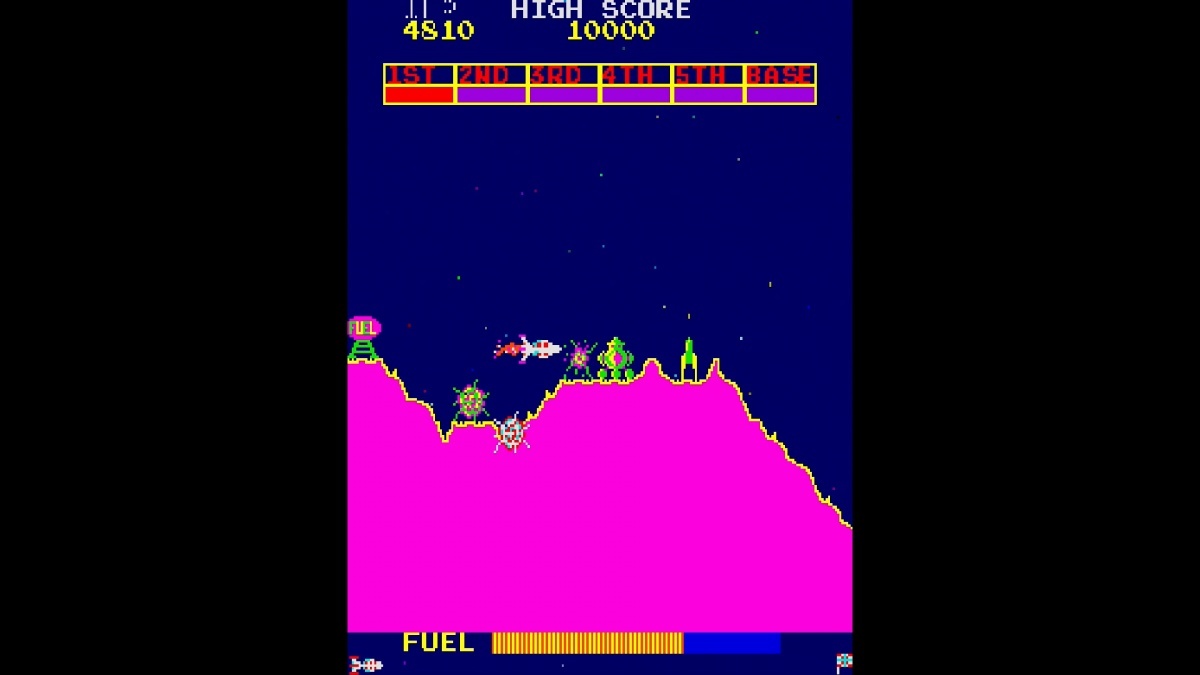
Scramble
The earliest arcade games tended to revolve around simple concepts, and this is one of them. The goal is to bomb the base, but pilots must first navigate through five treacherous waves of flying rockets, crafty UFOs, and furious fireballs. Also, the jet they're in control of is one of those rare video game vehicles that actually requires fuel. Conveniently, there are fuel tanks nestled between the rocky crags that make up each wave.
However, in order to get the fuel, players must master the bomb. Bombs travel at an arc, and the distance they travel can be affected by the direction the jet is moving. That said, keeping the fuel gauge topped off isn't hard, at least early on. There are tanks everywhere, and even someone who mashes away at the fire button can expect to grab most of them. This all changes when they reach the base.
Picture this: There's a large skyscraper with the word "KONAMI". Just behind it is the enemy base, nestled deep within a crevice. Hitting the base with a bomb (and not dying in the process) requires expert piloting and careful aiming. As long as their fuel holds out, the player gets as many chances as it takes. Mastering this one in a million shot takes a lot of practice, but nailing it is the only way to move onto the next loop.
Yep, there are multiple loops. The most noticeable change is that fuel gauge decreases at a faster rate than before. Given enough time, button-mashing through each wave is no longer an effective strategy. That also means that players have fewer chances to bomb the enemy base. This is about the time where Scramble earns its namesake. When someone realizes that they missed their shot, they have to quickly recover their bearings or "scramble", else they're going to be destroyed. It's a pretty decent shooter, though its appeal might be lost on anyone who can't stand video games made in the early 80s.
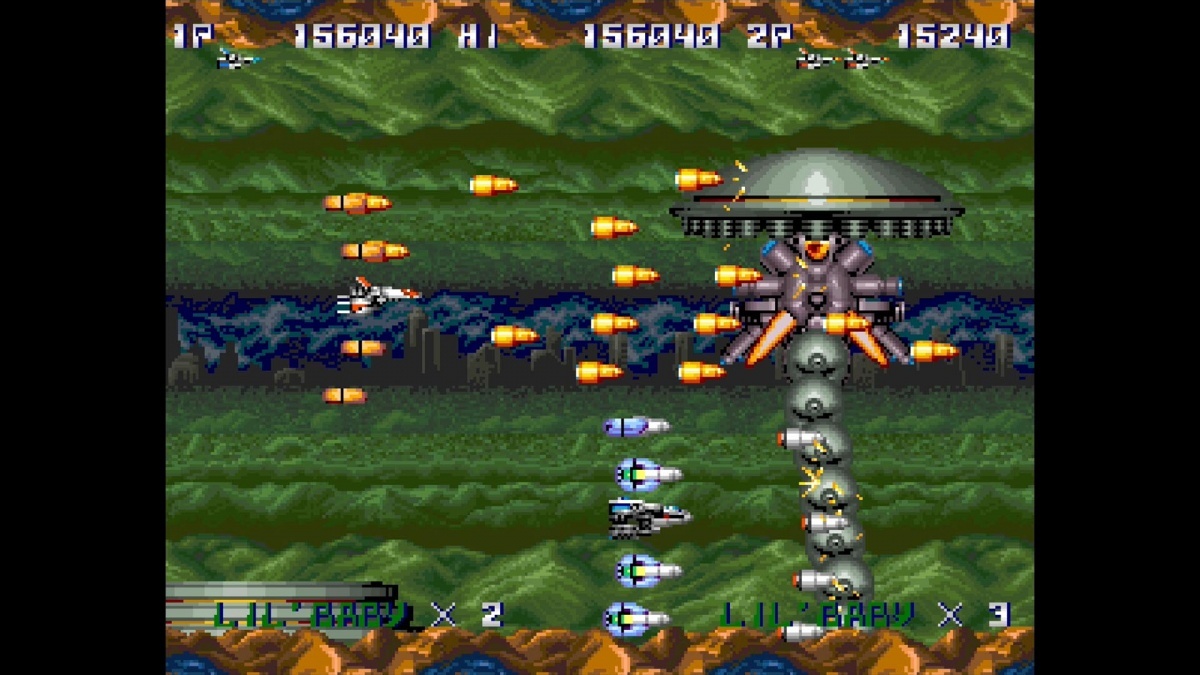
Thunder Cross
Hop in a space fighter; take on a mechanical army, and save the colony planet Hanium IV. This fill-in-the-blank plot sets up Thunder Cross, an underrated and very enjoyable shmup. Compared to most of the other games in the Anniversary Collection, this one is very easy to get into. The strategy rarely deviates from "shoot down enemies and dodge bullets". Furthermore, the ship begins with a pair of options, tripling its firepower. Last but not certainly not least is the "Lil' Baby". This super bomb clears the screen of danger, allowing the player a moment to catch their breath. These are best saved for emergencies, such as when dealing with the almighty spheroid.
It might seem a bit odd to dedicate a paragraph to a single enemy, but the spheroid is a very noteworthy adversary. At first glance, it's a harmless metal ball. However, once destroyed, it releases a spread of bullets. The spread is easy to dodge, but here's the kicker. Alongside the spread is a special homing bullet, and it will do its best to blindside the unaware. Aside from those jerks, the level of difficulty is pretty good. Each new stage is just a little more intense than the last, but it never gets overbearing.
This game encapsulates some of the finest aspects of its respective genre. Each stage offers a host of exciting challenges to deal with. Adapting to the constantly changing situations is both easy and fulfilling. It's a showcase for Konami's understanding of the fundamentals. The key to compelling entertainment isn't found in gimmicky scenarios and nonsensical twists. It's all about adhering to core tenements and ensuring that players always have an idea of what's coming next, and how to deal with it.
However, and this is a really big however, there are two versions of Thunder Cross. The one I covered in the previous few paragraphs is actually the weaker of the two. The Japanese version features a variety of weapons to obtain, the ability to manipulate options so that they cover a wider area, and the complete absence of "Lil' Babies". Extra lives can be earned by reaching certain score thresholds. Oh and the best part? Those spheroids that were mentioned earlier, they're nowhere to be found.
Altogether, the Japanese version is much easier. Perhaps, it might have even been a little too easy. Undoubtedly the Western release was an attempt to fix the problem, but the developer went too far. There's really no excuse for removing weapons and abilities from the game. The added super bombs definitely don't make up for the missing features, especially when all this critic used them for was to counter those darn spheroids.
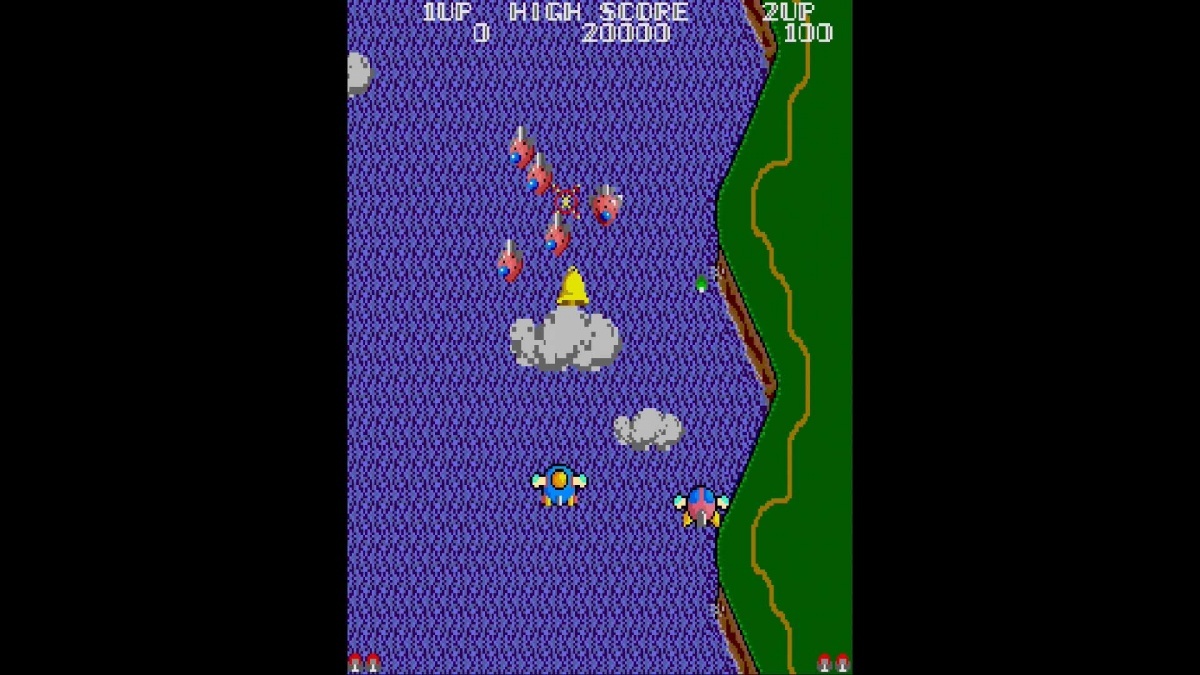
Twinbee
It's like Xevious, except cute. That's Twinbee in a nutshell. Up to two players can team up to wreak havoc on all sorts of random absurdities, both in the air and on the ground. Each stage ends with a boss-fight. These major adversaries toss around a lot of bullets, but once their weakpoint appears, they shouldn't take more than a few hits to defeat. The player-ships are unique in the sense that they can only throw bombs, as long as they have arms. Taking hits from the side will cause them to disappear. Thankfully, a handy ambulance will appear, allowing one the opportunity to get repairs. This can only be done once per life, so try and be careful.
Unlike most other Konami shooters, this one has a scoring system beyond "shoot all of the baddies". Hidden in the clouds are bells. When shot, they are liable to change colours. When blue, green, grey, or red bells are picked up, a power-up is acquired, such as extra speed or a twinshot. Yellow bells are worth 500 points to start, and steadily increase in value, provided one of them doesn't fall off-screen. Don't be surprised if things start getting a little chaotic, what with all of the bells and bullets flying everywhere. Players also will have to figure out the best times to lay off the fire button, in order to scoop up all of the valuables. Bells that are shot too many times will turn into bees. Don't try to collect the bees.
The unique scoring system is the heart of this game. Without it, there wouldn't be much to talk about. Repetition will quickly set in, simply because most of the stages are very similar to one another. Sometimes there are new obstacles to contend with, or perhaps the ground targets are arranged in a different manner. Otherwise, it's mostly just a matter of juggling bells, and wiping out wave after wave of oddities. Still, there is quite a bit of fun to be had. Trying again and again to better one's score is a fine way to burn through a few hours.
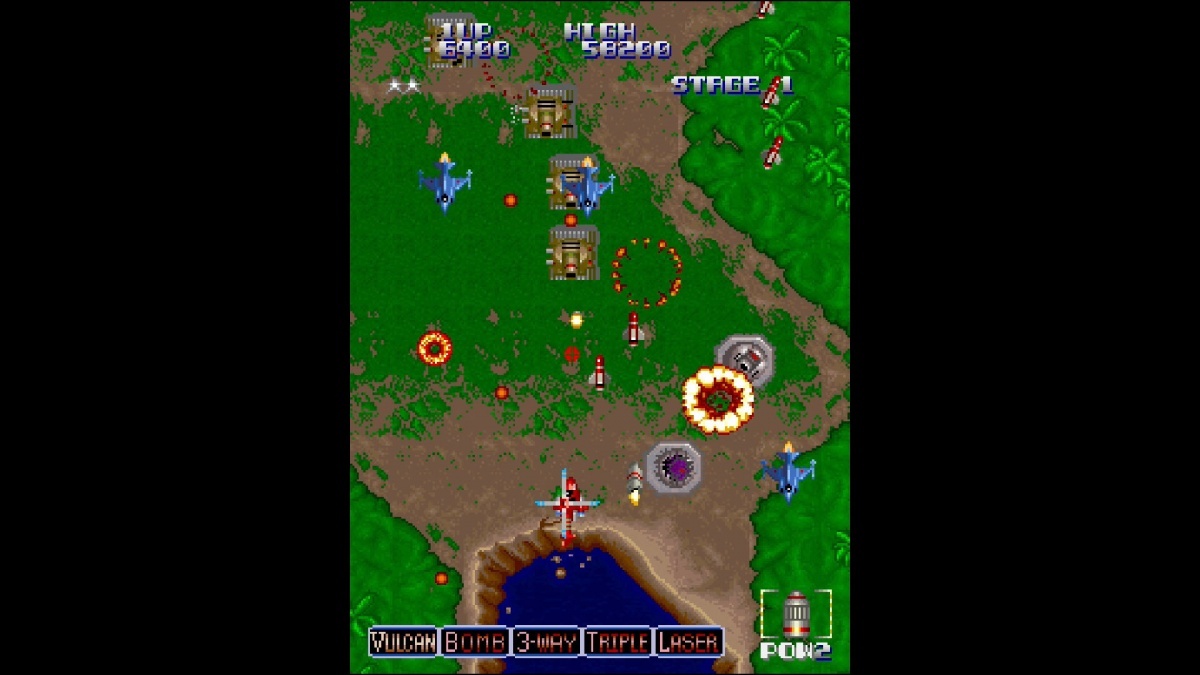
Typhoon
Upon starting Typhoon, players are immediately thrust into the pilot's seat of an F-14. After a 3D dogfight with wave after wave of enemy jets, they must then destroy a battleship. Whoa, hang on a second. Is this Afterburner? Not really. After completing the first mission, the pilot is then asked to command a chopper deep into enemy territory. What follows is a standard overhead shooter, but with the occasional deviation into 3D action.
Much like Twinbee, one must be equally skilled in shooting down enemy ships and bombing their anti-aircraft weaponry. The copter's default armaments aren't all that useful. Thankfully, occasional red ships will drop power-ups, allowing one the chance to equip one of four special weapons. Lasers do great damage, but the triple missile's range is sometimes preferable. There's a 3-way shot as well, which is handy for hitting anything that approaches from the sides. Speaking of, ships can approach from most any direction, even from behind. Unannounced attacks from the rear may be commonplace in the STGs of yore, but that doesn't make them any less annoying.
Oh and one more thing. This is another one of those checkpoint shmups. Well, perhaps "chokepoint" is the better word for it. A significant portion of the average play-through will be spent re-doing extremely difficult areas. Players may find themselves gasping for air as they're overrun by bullets, homing missiles, and whatever other evil tricks the enemy has up their proverbial sleeves. Even those who've long given up on ever achieving a 1CC will find themselves struggling just to get past the second stage. All in all, this game is decent, but not all that remarkable.
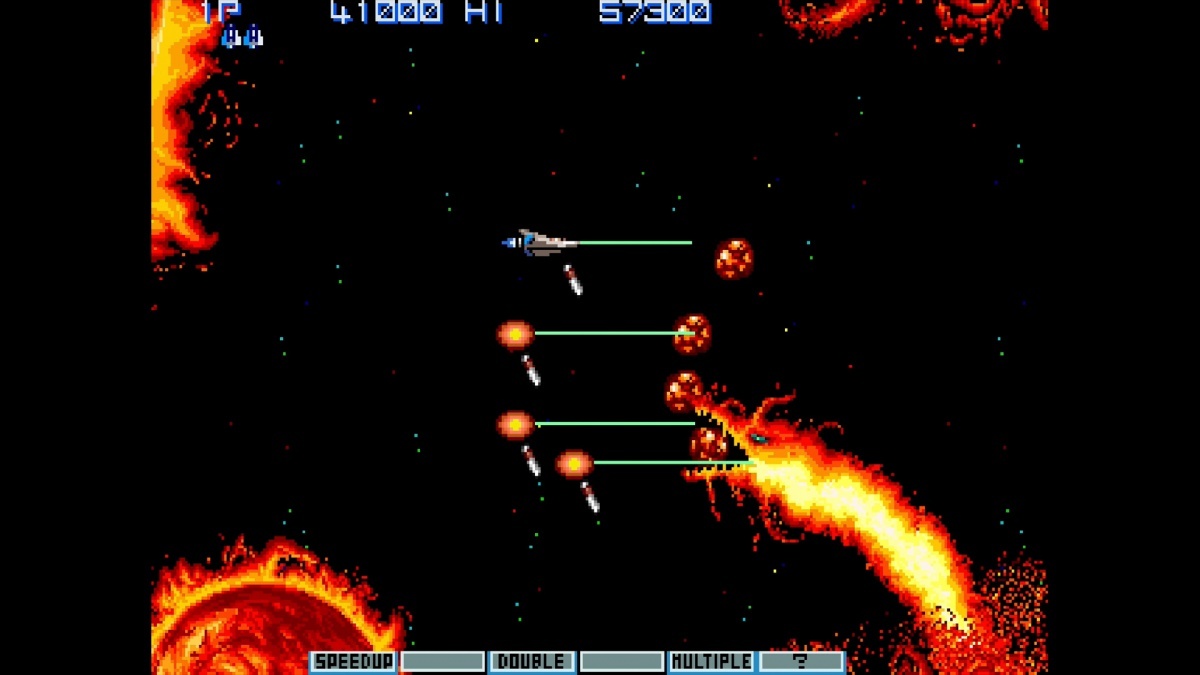
Vulcan Venture
Gradius II aka Vulcan Venture is essentially the blueprint that all future games in the Gradius franchise would follow. Each stage has its own specific theme, with appropriate obstacles to overcome. The ever-popular boss rush and speed stage make their first appearance here as well. The power-up system has also seen a few refinements. There are now multiple weapon-sets to choose from, as well as a choice between a shield and a forcefield. Although, it's worth noting that anything that so much as breathes in the Vic Viper's direction will cause the forcefield to dissipate. Still, it's a nice gesture, and might even save a life.
For everyone out there that can't stand checkpoint shooters, please preserve your sanity, and avoid this title at all costs. It starts out easy enough, maybe even a little too easy. Unlike Nemesis, there aren't any headaches in the early stages. That all changes by the time the Moai head stage rolls around. These Easter Island rejects are going to cough up hundreds of thousands of deadly rings. Anyone foolish or unlucky enough to die here will be forced to redo the hardest portion, with little more than a speed power-up. Yes, merely being kicked backwards isn't enough. This game isn't satisfied until it puts its players in the absolute worst situations.
Let's just go ahead and say it, Gradius II despises failure, and takes great delight in punishing it as severely as possible. Dying at any point in the boss rush, even at the "last boss", will result in a swift kick back to the beginning of the rush. The worst of it is in the final stage. If a pilot can't overcome the mid-boss, they're placed in a hallway with over a dozen enemies parked right in front of them. In less than a second, they all start firing. Later on, there's a part where both the floor and ceiling crumble up and hurl themselves at unsuspecting Vic Vipers. This point is the worst of the worst. Anyone who ends up here with no power-ups is guaranteed to never get any further. They will be overwhelmed and crushed, and whatever amount of extra lives they have remaining won't matter one bit.
This STG is one that could've gone down as an all-time great, but its insistence on soul-eroding checkpoints ensures that only an especially dedicated crowd will appreciate it. Every other necessary element is there, including Konami's trademark attention to mechanics and design. It's just that when things go wrong, and they will, there's nothing left but suffering. Is that really what shmups are all about? Probably not, but that didn't stop the developer from twisting the knife even further with Gradius III. That's a story for another day, preferably a day millions of years from now.
The Arcade Classics Anniversary Collection
As always, the biggest concern with classic game compilations isn't the library, but rather the emulation quality and features. Thankfully, all eight of the games play very well. Stuttering isn't an issue, nor will players ever have to worry about dropped inputs. Every title supports both save-states and button configuration. Players are also free to enable auto-fire on their favourite shmups, saving them the annoyance of having to constantly mash buttons. The visual options are a little sparse. One can choose to enable "blurring", which seems to resemble scanlines. Disappointingly, there isn't any support for online leaderboards.
Until recently, this collection's most significant issue was that there wasn't an option to change regions. Konami has created some of the best games the world has ever known, but there have been times where they'd make significant changes to titles that were released in the West. Any fan of Contra: Hard Corps will point out that the Japanese version included a life meter, which was removed in other versions. Granted, a Contra game where nobody dies in one hit is a bit strange, but it would have made for a nice "easy mode." Castlevania III: Dracula's Curse was also a stiffer challenge outside of Japan. Maybe this was done in an attempt to counter the burgeoning rental market. Someone is probably more likely to buy a game if they can't complete it within a couple days.
When it came to the arcades, it really felt like Konami's western division operated under a different philosophy. Games released outside of Japan were often subjected to massive overhauls, or seemingly minor adjustments that completely changed how they were played. As pointed out earlier in this review, the North American version of Thunder Cross is inferior when compared to the original. By increasing the amount of damage enemies did, Haunted Castle's level of difficulty was changed from "Very Hard" to "Intolerable." Other notable titles like X-Men and The Simpsons changed or removed healing items. Crime Fighters replaced health meters with ticking clocks, guaranteeing that the heroes would run out of life, even if they were never even punched.
Besides wringing more quarters out of players, none of these changes served any purpose. In most cases, they were actually detrimental, as if nobody had bothered to do any play-testing. Balancing the difficulty of a game is not an easy task, especially when it came to arcades. Many of them were subject to location-tests, the "open-beta" of the '80s and '90s. Players of all skill levels would give their input, and the developers would then make the necessary adjustments. When these games were revised for western audiences, it really feels like the all-important testing phase was skipped. Questions like "How will players solve this problem?" were met with "Who cares?" thus the final product tended to be something that was far more difficult than it should've been.
Thankfully, it seems that Konami has heard all of the complaints, and are updating the collection so that it includes region-select. This update will also include TATE support for Switch owners. Anyone playing undocked can rotate their handheld 90 degrees and enjoy vertically-oriented games in their intended aspect ratio.
Cubed3 Rating
Very Good - Bronze Award

With the addition of region-select, Konami's Arcade Classics Anniversary Collection has become the easy recommendation it deserves to be. An eclectic array of games is included in this set, and most of them are still quite entertaining. The newly-added region-select option allows players the chance to study how different approaches to difficulty can affect a title. It's rather fascinating how a few simple changes can create new challenges. All in all, it's a worthwhile pick-up for arcade fans.
Comments
Comments are currently disabled

 Sign In
Sign In Game Details
Game Details
 Out now
Out now  Out now
Out now  Out now
Out now  Out now
Out now  Subscribe to this topic
Subscribe to this topic Features
Features





 Top
Top

